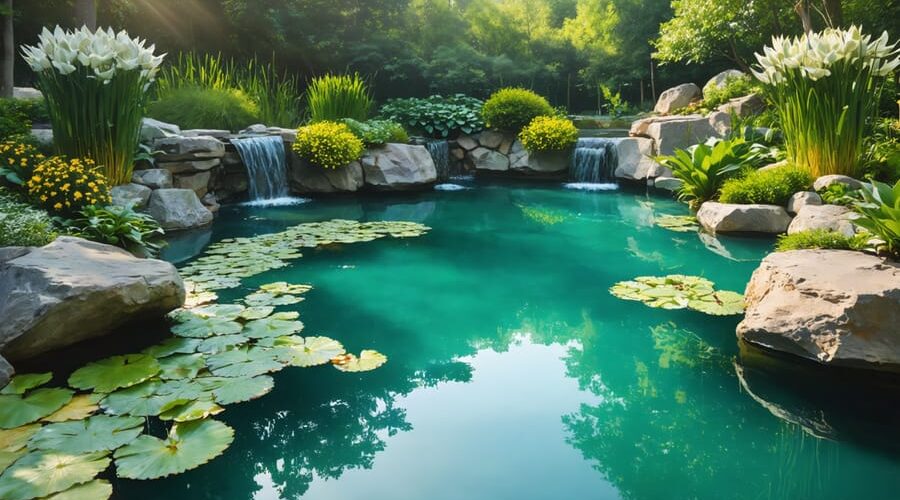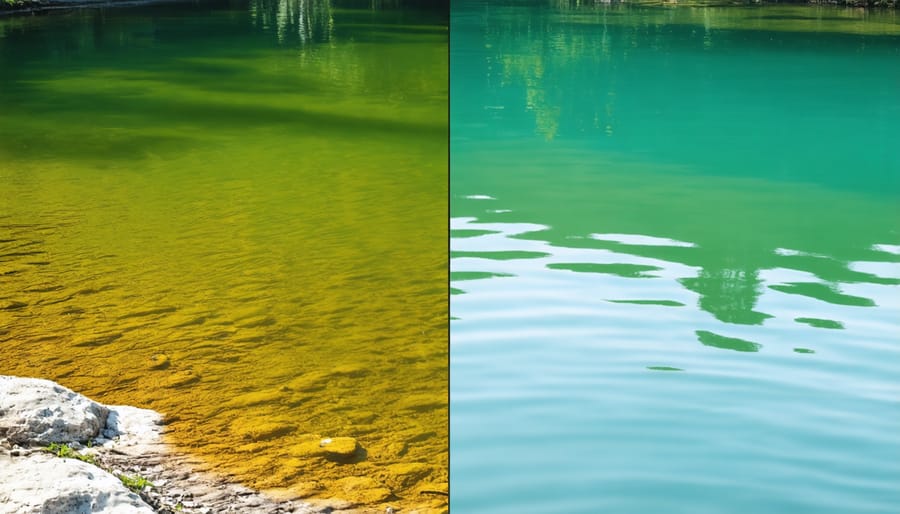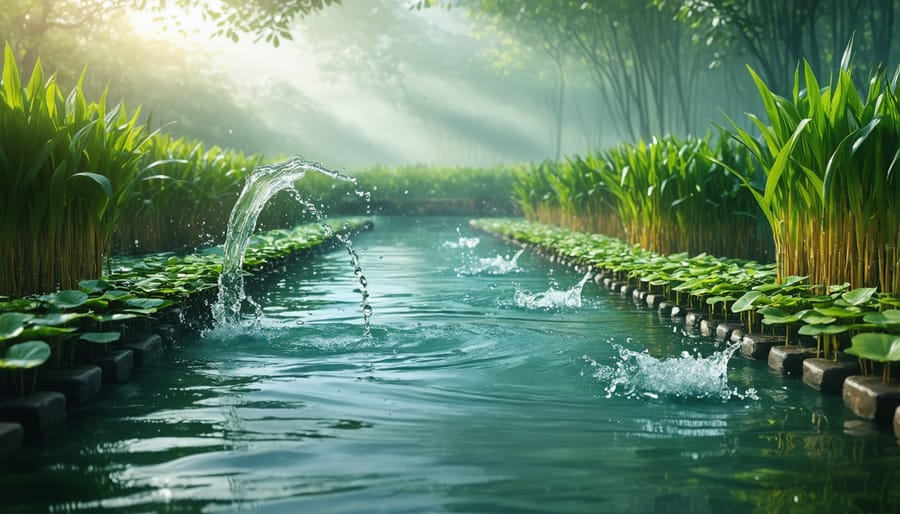
Transform Your Pond Water Into Garden Gold: Smart Treatment Methods That Work
Transform stagnant pond water into a garden-ready resource by implementing a three-stage filtration system with mechanical, biological, and UV components. Install an aerator or fountain to maintain optimal oxygen levels, preventing algae growth and supporting beneficial bacteria. Test water quality weekly using a comprehensive kit to monitor pH, ammonia, and nitrate levels, ensuring safe reusing pond water effectively for garden irrigation. Add beneficial bacteria supplements monthly to break down organic matter and maintain a healthy ecological balance.
The treated water becomes a sustainable solution for garden irrigation, reducing water bills while providing nutrient-rich nourishment for plants. Natural filtration methods, including floating plants like water hyacinths and submerged vegetation, work alongside mechanical systems to purify water continuously. This integrated approach creates a self-sustaining ecosystem that benefits both pond life and garden growth, making pond water treatment an essential practice for any water gardener.
Why Treat Pond Water Before Garden Use?

Common Pond Water Concerns
Every pond owner faces common water quality challenges that require attention. Algae growth is perhaps the most frequent issue, turning clear water into a murky green soup and potentially harming aquatic life. Falling leaves and organic debris can accumulate at the bottom, decomposing and releasing excess nutrients that further feed algae blooms.
High nutrient levels, particularly from fish waste and decomposing plant matter, can throw your pond’s ecosystem out of balance. These nutrients often lead to poor water quality and can encourage unwanted plant growth. Additionally, stagnant water may harbor harmful bacteria and parasites that could affect both aquatic life and plants if used for garden irrigation.
Temperature fluctuations and insufficient oxygen levels can compound these problems, especially during hot summer months. Understanding these common concerns is the first step toward maintaining a healthy pond ecosystem and ensuring your water is safe for garden use.
Benefits for Your Garden
Treated pond water is a hidden treasure for your garden, packed with nutrients that can give your plants an extra boost. Unlike tap water, properly treated pond water contains beneficial microorganisms, natural fertilizers, and essential minerals that promote healthy plant growth. When you understand the pond irrigation benefits, you’ll discover it’s like serving your plants a wholesome, nutrient-rich smoothie!
The organic matter and fish waste in treated pond water break down into nitrogen, phosphorus, and potassium – the three main nutrients plants need to thrive. This natural fertilizer can help reduce your gardening costs while promoting sustainable practices. Plus, the beneficial bacteria present in treated pond water can improve soil health and enhance your plants’ natural defense mechanisms against diseases.
Your garden will thank you with lusher growth, more vibrant blooms, and healthier produce. It’s a wonderful way to create a closed-loop system in your backyard, where every drop of water serves multiple purposes.
Natural Filtration Methods
Plant-Based Filtration
Plant-based filtration is one of the most effective and natural ways to maintain a healthy natural pond ecosystem. Aquatic plants like water lilies, rushes, and cattails act as living filters, absorbing excess nutrients and harmful compounds from the water while providing shelter for beneficial bacteria.
These helpful bacteria work alongside plants to break down organic waste, converting it into nutrients that plants can use. Water hyacinth and duckweed are particularly excellent at removing nitrogen and phosphorus, though they require regular thinning to prevent overgrowth.
To establish plant-based filtration in your pond, start by introducing a variety of plants in different zones. Place marginal plants like iris and rushes along the edges, submerged plants like hornwort in deeper areas, and floating plants on the surface. Aim for about 60% plant coverage of your pond’s surface area.
For best results, combine multiple plant species and allow beneficial bacteria colonies to establish naturally. You can speed up this process by adding bacterial supplements, especially when first setting up your pond or after major cleanings. Remember to maintain your plants by removing dead foliage and dividing overgrown specimens seasonally to keep your natural filtration system working efficiently.

DIY Filter Systems
Building your own pond filter system can be both cost-effective and rewarding. The simplest DIY filter starts with a large plastic container or bucket with small holes drilled in the bottom. Layer the container with different filtering materials, starting with larger stones at the bottom, followed by gravel, and topped with fine sand.
For a more advanced system, try creating a three-stage filter using plastic storage containers. Connect them in series using PVC pipes and fittings. The first container should contain filter foam or pond matting to catch large debris. Fill the second with bio-balls or plastic pot scrubbers to provide surface area for beneficial bacteria. The final container can house activated carbon or zeolite for chemical filtration.
A natural bog filter is another excellent option. Dig a shallow trench near your pond and line it with pond liner. Fill it with gravel and plant water-loving plants like cattails or rushes. The plants and gravel work together to filter water as it flows through.
Remember to include a pump to move water through your filter system. Start with a flow rate that cycles your entire pond volume once every two hours. Position your filter system slightly above pond level to allow easy maintenance and cleaning.
Regular maintenance is crucial – clean mechanical filters monthly and replace filter media as needed. With proper care, your DIY filter will keep your pond water crystal clear.
Chemical Treatment Options
pH Balancing
Maintaining the right pH balance in your pond is crucial for the health of your aquatic ecosystem. The ideal pH range for most pond life is between 6.8 and 7.8, with 7.0 being neutral. Testing your pond water weekly with a reliable pH test kit will help you stay on top of any fluctuations.
If your pond water is too acidic (below 6.8), you can gradually raise the pH by adding limestone or crushed coral. Spread these materials in a mesh bag and place them in areas with good water flow. For alkaline water (above 7.8), consider adding peat moss in mesh bags or using commercial pH-lowering products specifically designed for ponds.
Natural solutions like adding beneficial bacteria can help stabilize pH levels over time. These microscopic helpers break down organic matter and help maintain a balanced ecosystem. Adding appropriate aquatic plants also helps regulate pH naturally, as they absorb excess nutrients that could affect water chemistry.
Remember to make pH adjustments gradually – sudden changes can stress your pond inhabitants. Always add treatments in small amounts and test the water 24 hours after each adjustment. If you’re dealing with persistent pH issues, check your water source and consider using a pond buffer to maintain stability.
Safe Additives
When it comes to treating your pond water safely, several garden-friendly additives can help maintain water quality without harming your aquatic ecosystem. Beneficial bacteria supplements are excellent natural clarifiers that help break down organic waste and reduce ammonia levels. These microscopic helpers work continuously to keep your pond balanced and clear.
Natural barley extracts are another fantastic option, acting as a natural algae preventive while being completely safe for fish and plants. You can find these in liquid form or as barley straw pellets, both of which slowly release their beneficial compounds into the water.
Enzyme treatments specifically designed for ponds help decompose dead plant material and fish waste, reducing the overall maintenance needed. These work particularly well when combined with beneficial bacteria for a comprehensive treatment approach.
For quick water clarity, natural clay-based clarifiers can help clump floating particles together, making them easier to filter out. These are especially useful after heavy rains or when your pond becomes cloudy.
Remember to always choose products specifically labeled for pond use and follow dosage instructions carefully. Regular, small treatments often work better than large, occasional doses, helping maintain a stable and healthy pond environment year-round.
Setting Up Your Water Treatment System
Equipment Needed
To effectively treat your pond water, you’ll need several essential pieces of equipment. Let’s start with a reliable water testing kit, which should include tests for pH, ammonia, nitrites, and phosphates. This will help you monitor your water quality and determine the right treatment approach.
For filtration, you’ll need both mechanical and biological filters. A good mechanical filter, such as a skimmer or pressure filter, removes debris and particles. A biological filter, like a filter box with bio-media or a constructed wetland area, helps beneficial bacteria thrive and break down harmful compounds.
An aerator or air pump with air stones is crucial for maintaining healthy oxygen levels. For larger ponds, consider a fountain or waterfall feature, which not only adds beauty but also helps with aeration.
You’ll also need:
– A pond vacuum or net for removing settled debris
– UV clarifier to control algae (optional but recommended)
– Treatment chemicals based on your specific needs
– Clean containers for measuring and mixing treatments
– Protective gear (gloves and safety goggles)
– A long-handled brush for cleaning sides
– Water pump for circulation
– Timer for automated equipment
For maintenance and application, keep basic tools like buckets, hoses, and measuring cups handy. Store all equipment in a dry, protected area when not in use, and regularly check that everything is functioning properly to ensure consistent water quality.

Installation Steps
Begin by selecting a suitable location for your pond water treatment system, ensuring easy access for maintenance and proximity to both your pond and garden areas. Clear the space of debris and create a level surface using gravel or concrete blocks if needed.
Start the installation by connecting your pond pump to food-grade flexible tubing. Position the pump in the deepest part of your pond, securing it slightly above the bottom to avoid sucking up sediment. Run the tubing along a safe route to your treatment setup.
Next, install your filtration system. For a basic setup, connect a mechanical filter first to remove larger particles, followed by a biological filter for beneficial bacteria growth. When maintaining pond water quality, proper filter placement is crucial for optimal flow.
Set up your UV clarifier if you’re using one, positioning it after the filtration system. Ensure all connections are watertight using appropriate clamps or fittings. Create a stable platform for your collection tank, which will store the treated water.
Finally, install a distribution system for your garden. This could be as simple as a spigot and garden hose, or you might opt for a drip irrigation system. Test the entire setup by running water through it slowly, checking for leaks and proper flow. Make any necessary adjustments to ensure smooth operation before full implementation.
Maintenance and Monitoring
Testing Parameters
Regular water testing is essential for maintaining a healthy pond ecosystem. Test your pond water at least once a week during the active growing season (spring through fall) and bi-weekly during winter. The key parameters to monitor include:
pH levels (ideal range: 6.5-8.5): Test weekly to ensure your pond maintains proper acidity levels for plant and fish health.
Ammonia and nitrites (target: 0 ppm): Check twice weekly if you have fish, as these compounds can be toxic even in small amounts.
Dissolved oxygen (ideal: 6-8 ppm): Monitor monthly or more frequently during hot weather when oxygen levels naturally decrease.
Phosphate levels (below 0.2 ppm): Test monthly to prevent excessive algae growth.
Temperature: Check daily during extreme weather conditions to protect fish and plants.
Keep a logbook of your test results to track changes over time and identify potential problems early. Many pet stores offer free water testing services if you’re unsure about doing it yourself. Remember that consistent monitoring is better than sporadic testing, as it helps you spot trends and take corrective action before issues become serious.
Routine Maintenance
To keep your pond water treatment system running smoothly, perform these essential maintenance tasks regularly. Check and clean your filters weekly, removing any debris or buildup that could reduce their effectiveness. Test your water quality at least once a month, measuring pH, ammonia, and nitrate levels to ensure they’re within acceptable ranges.
Inspect pumps and aerators every two weeks, clearing any blockages and ensuring proper flow. During spring and fall, remove fallen leaves and organic matter before they can decompose and affect water quality. Trim aquatic plants monthly to prevent overgrowth and maintain proper nutrient balance.
Keep detailed records of your maintenance activities and water test results. This helps you spot patterns and address potential issues before they become problems. In winter, adjust your maintenance schedule based on your climate, focusing on preventing ice damage and maintaining minimal circulation if needed.
Remember to clean your UV clarifier bulbs quarterly and replace them annually for optimal performance. Regular maintenance not only keeps your pond healthy but also reduces the need for major interventions later.
Maintaining healthy pond water doesn’t have to be complicated or overwhelming. By following the treatment methods we’ve discussed, you can create a thriving aquatic ecosystem that benefits both your pond life and garden. Remember to regularly test your water quality, implement a combination of mechanical and biological filtration, and consider natural treatment options like beneficial bacteria and aquatic plants.
Start small with basic treatments and gradually expand your pond care routine as you become more comfortable. The key is consistency – regular maintenance prevents major issues from developing and keeps your pond water crystal clear. Don’t forget that a healthy pond is a balanced ecosystem, so avoid over-treating or using harsh chemicals that might disrupt this natural balance.
Whether you’re planning to use your pond water for garden irrigation or simply want to maintain a beautiful water feature, these treatment methods will help you achieve your goals. With proper care and attention, your pond can become a stunning centerpiece of your outdoor space while providing valuable water resources for your entire garden.
Keep learning, stay observant of your pond’s needs, and enjoy the rewarding process of maintaining a healthy aquatic environment.
